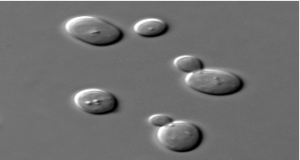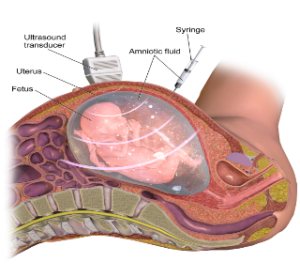This page contains the detailed and easy notes for GCSE OCR 21st Century Biology You and You Genes for revision and understanding You and You Genes .
Banner 1
GCSE OCR 21st Century Biology You and You Genes Complete Revision Summary
You and you Genes
You and you Genes
- Eukaryotic and Prokaryotic Cell
- Animal Cell and Plant Cell
- Specialized Plant Cells
- Specialized Animal Cells
- Microscopy
- Culturing Microorganisms
- Cell Division: Mitosis
- Stem Cells
- Diffusion
- Osmosis
- Active Transport
- Sexual and Asexual Reproduction
- Meiosis
- DNA
- Mutation
- Inheritance
- Genetic Diseases
- Sex Determination
- Variation
- Evolution
- Selective Breeding
- Genetic Engineering
- Speciation
- Theories of Evolution
- Speciation
Eukaryotic Cells – Plants and Animals
Prokaryotic Cells – Bacteria
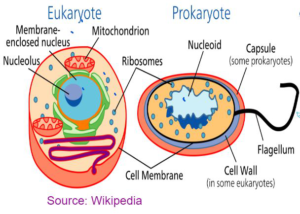
| EUKARYOTIC | PROKARYOTIC |
| Nucleus is present. | Nucleus is absent. |
| All membrane bound organelles are present | Membrane bound organelles are absent. |
| DNA is enclosed in the nucleus | DNA lies naked in the cytoplasm. |
| They are multicellular | They are mostly unicellular |
| DNA is linear | DNA Is circular |
| Ribosomes are big | Ribosomes are small |
| They are big cells | They are small cells. |
| Example: Plants and Animals | Example: Bacterial Cell |
Banner 2
Animal Cells
NUCLEUS
- It is the brain of the cell
- It controls the activities of the cells
- It contains DNA which holds our genetic information.
RIBOSOMES
- It is the site for protein synthesis.
- They are involved in making of proteins and enzymes required by the cell
CYTOPLASM
- Jelly like fluid which fills the cell.
- It is the site where all the chemical reactions of the cells take place as it contains all the major enzymes
CELL MEMBRANE
- It the membrane that surrounds the cells
- It controls what goes in and out of the cell.
MITOCHONDRIA
- It is the powerhouse of the cell
- It produced energy for the cell as it is the site for aerobic respiration
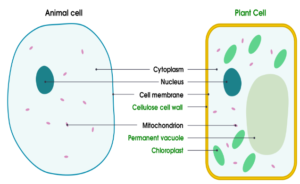
Banner 3
Plant Cell
PERMANENT VACUOLE
- It is filled with cell sap.
- It gives rigidity to the cells and makes the cell turgid
CELL WALL
- Made up of cellulose.
- It is the layer outside of the cell membrane
- It supports the plant and maintain its shape.
CHLOROPLAST
- It is the site for photosynthesis
- It contains a green pigment, chlorophyll which absorbs light and prepared food.
Plant versus Animal Cell
| ORGANELLE | Plant Cell | Animal Cell |
| Nucleus | Present | Present |
| Cell Membrane | Present | Present |
| Mitochondria | Present | Present |
| Ribosomes | Present | Present |
| Cytoplasm | Present | Present |
| Cell Wall | Present | Absent |
| Permanent Vacuole | Present | Absent |
| Chloroplast | Present | Absent |
Banner 4
Bacterial Cell
Cell Wall
- No cellulosic
- made up of peptidoglycan
Circular DNA
- No nucleus
- Single DNA loop found naked in the cytoplasm
Plasmid
- Extra chromosomal materials
- They are in the form of small rings
- They give special properties to bacteria like antibiotic resistance
Pilli
- Hair like structures
- Found on the surface
- That helps bacteria to reproduce
Capsule
- Slime layer
- that protects the bacteria
Flagellum
- Tail like structure
- Helps the bacteria to move.
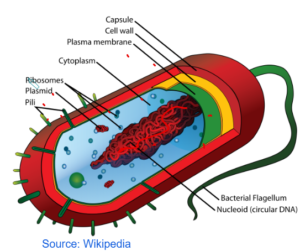
Banner 5
[download_after_email id=”10239″]
BACTERIAL VERSUS PLANT VERSUS ANIMAL CELLS
SPECIALISED ANIMAL CELLS
Special cells which have some extra features that allows them to perform specific functions
NERVE CELL
Function is to send electrical impusles round the body
- Dendrites – They are hair like structures that receives the impulses
- Axon – Long stalk the transmits the nerve impulses
- Synapse – They transmit impulses from one neurone to another
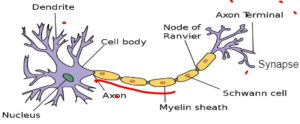
MUSCLE CELL
- Functions is to contract to bring about the movement of different parts of the body
- They are made up of special fibres which helps them to contract and relax
- Contain special proteins that allows them to contract and relax
- They have loads of mitochondria which provides them energy to contract
- They can store special storage carbohydrate called glycogen which acts as fuel for the muscles
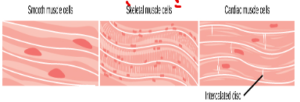
SPERM CELL
Functions is to swim to the egg and fertilize it
- Flagella – Helps it to swim to large distances
- Mitochondria – Provides Energy to swim
- Nucleus – Contains genetic information
- Acrosome – Contains Hydrolytic enzyme to break the egg wall and penetrate inside the egg to fuse with the egg nucleus

Specialized Plant Cells
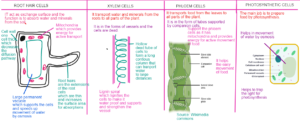
MICROSCOPES
Are the devices that use to see the cells which we cannot see by our naked eye.
MAGNIFICATION
The property of the microscope to enlarge the object.
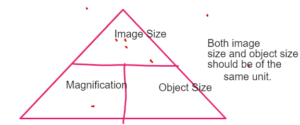
RESOLUTION
The property of the microscope to distinguish between two closed placed objects.
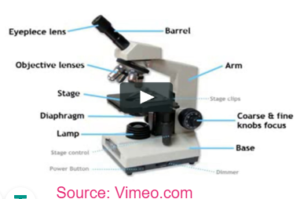
Baneer 6
Light and Electron Microscopes
| LI&HT MICROSCOPES | ELECTRON MICROSCOPES |
| Uses beam of light to focus on the object. | Use beam of electron.to focus on the object. |
| It is easy to handle | It is not easy to handle |
| It is small and compact | It is big and non portable |
| It does not require much expertise to handle | It requires proper training to handle |
| It can view the live samples | Samples have to be dead |
| No special sample preparations are required | Special sample preparations ace required |
| Lower resolving power – 0.2μm | Greater resolving power 0.5nm |
| Small magnifying power – x1000 -1500 | Greater magnifying power – x100000 |
| Can form colour images | Form 2D or 3D black and white images |
Banner 7
MOVEMENT OF SUBSTANCE IN AND OUT OF THE CELLS
ACTIVE TRANSPORT
- Movement of particles from a region of low concentration to a region of high concentration.
- Particles move against the concentration gradient.
- It requires energy.
- Cells involved in active transport should have lots of mitochondria
PASSIVE TRANSPORT
- Movement of particles from the region of high concentration to a low concentration.
- Particles move along the concentration gradient.
- It does not require energy
- Having numerous mitochondria is not a requirement
DIFFUSTON
OSMOSIS
Banner 8
DIFFUSION
- It the net movement of particles from an area of higher concentration to an area of lower concentration.
- It is passive process
- It happens along the concentration gradient
- No use of energy.
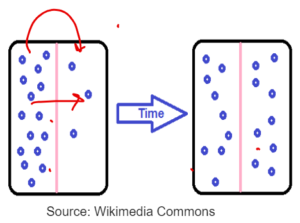
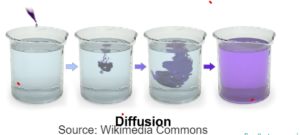
Banner 9
FACTORS AFFECTING DIFFUSION
SURFACE AREA
- Greater the surface area greater is the rate of diffusion as particle will get more room for movement.
- All the exchange surfaces have greater surface area like root cells has root hairs and intestine cells has villi.
CONCENTRATION GRADIENT
- Greater the difference in concentration in the two region greater is the rate of diffusion.
- All the exchange surfaces maintain steepest concentration gradient
- Like root cells are closed to xylem and Villi has rich blood supply.
DIFFUSION DISTANCE
- Smaller the diffusion distance greater is the rate of diffusion as the particles have to travel a smaller distance.
- All the exchange surfaces maintain a smaller diffusion distance by being one cell thick.
TEMPERATURE
- Greater the temperature greater is the rate of diffusion as particles will get more kinetic energy for movement
- Rate of Diffusion = Surface area x Concentration gradient/Diffusion Distance
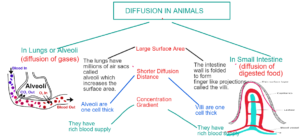
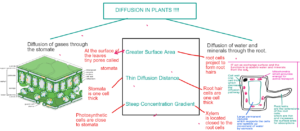
OSMOSIS – Special Case of Diffusion
Osmosis is the net movement of water particles from the region of high concentration of water particles to low concentration of water particles across a semi permeable membrane.
Movement of water from a dilute solution to a concentrated solution through a semi permeable membrane.
Special Case:
- It is the diffusion of only water molecules
- It required a semi permeable or partially membrane
- Membrane that allows only specific molecules to pass through like water.
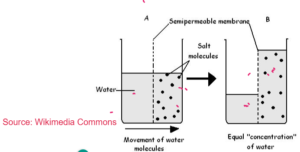
OSMOSIS IN PLANTS
- Hypertonic – The outer solution has a less concentration of water than inside the cell.
- Isotonic – The outer solution has same concentration of water than inside the cell.
- Hypotonic – The outer solution has a greater concentration of water than inside the cell.
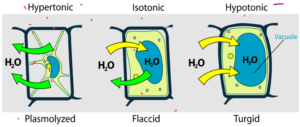
Plasmolyzed – The water moves out of the cells due to osmosis due to higher concentration of water inside the cell than outside. The cell membrane recetes from the cell wall
Flaccid – There will no net water movement so no pressure on the cell. It will be flaccid
Turgid – The water moves into the cell due to osmosis due to higher concentration of water outside the cell. The water will create pressure called turgor pressure on the cell wall making cell rigid and turgid.
Osmosis in Animals
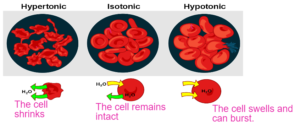
ACTIVE TRANSPORT
- Movement of substances from the region of low concentration to a region of higher concentration with the use of energy.
- Dependent on respiration as it requires energy. So the cells involved in active transport has lots of mitochondria.
- In Plants water and minerals are absorbed by active transport to absorb maximum of water and minerals.
- In animals, the digested food gets absorbed into the blood by active transport to ensure maximum absorption
- Salt glands are present in some marine organisms which removes the salt by active transport.
Banner 10
CELL CYCLE
Interphase –
- It is the longest phase of the cell cycle
- The cell grows in size and prepares all the proteins and enzymes needed for division.
- Replication of DNA where DNA duplicates its content.
Mitosis
- It is the division of the nucleus in which parent cell splits into two daughter nuclei containing same number of chromsomes as the parent cell.
Cytokinesis
- It is the division of the cytoplasm which .takes place after the division of the nucleus.
Mitosis
- It is the type of cell division in which a parent nucleus divides to form two daughter nuclei with exactly the same number of chromomes as that of the parent nucleus.
- The daughter cells produced are genetically identical to the parent and are clones.
- This division is important for growth, regneration and repair.
- Mitosis is also important in asexual reproduction.
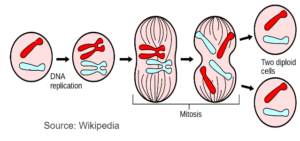
CELL DIFFERENTIATION
- It is the process by which cell becomes specialised to perform a specific function.
- Male Parent (23 pairs of chromosomes) Meiosis
Sperm (male gamete)
- Female Parent (23 pairs of chromosomes) Meiosis
Ovum (Female gamete)
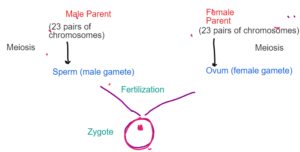
Animal Differentiation
- In animals majority of the cells are differentiated at an early stage and different cells have specific functions like nerve cell, muscle cells.
- Adult stem cells replaced the old and worn out cells in human but adult stem cells have limited specialization power
- Majority of the differentiation is permanent
Plant Differentiation
- Plants are the storehouse of stem cells
- Root meristems and shoot meristems are the parts of actively growing part of the cells which contains stem cells.
- The plants can be cloned easily as it has many undifferentiate cells and differentiation is not permanent.
STEM CELLS
- Undifferentiate mass of cells that can differentiate into any cell type are known as stem cells.
- Sources of Stem Cells : Embryo, left over remains of the embryo and the umbilical chord are the sources of embryonic stem cells.
- Bone marrow is the source of adult stem cells.
- Can solve the rejection problem if the transplanted organ is made from the person’s own stem cells.
- Can be possible cure of neuro-degenerative diseases
- Can be the potential cure of diabetes.
- Therapeutic cloning.
- Organ damage problem
ISSUES AGAINST STEM CELLS
- It can lead to cancer as the stem cells are rapidly dividing.
- The stem cells can be contaminated and can cause unwanted diseases to the patient.
- Research is still slow and expensive
- Research happens on aborted embryos which is considered as a potential source of life and many religions have ethical concerns against it.
- The knowledge of the genes switched on and off using differentiation is still incomplete.
Banner 11
KEY TERMS!!!
- Cells – Basic structural and functional unit of the living organism.
- Mitochondria —The cell organelle which is the site of aerobic respiratiom
- Nucleus — The cell organelle which controls the activities of the cell
- Cytoplasm –The jelly like fluid which fills the cell and contains enzymes for chemical reactions.
- Ribosomes — The cell organelle which is the site for protein synthesis
- Prokaryotic – Cell The primitive cell without nucleus or membrane bound organelles.
- Eukaryotic cell —The advanced cell type with nucleus and membrane bound organelle
- Cell Wall— The outer layer of the plant cell which provide shape and support
- Cell Membrane – The layer that controls what goes in and out of the cell.
- Vacuole – Organelle present in plant cell which has cell sap and make the cell turgid.
- Microscopes – Devices that is used to see the object which are not visible by a naked
- Resolution – Ability to distinguish between closely placed objects.
- Magnification — Ability to enlarge an object
- Xylem – Transport tissue in plants that transports water and minerals.
- Phloem – Transport tissue in plants that transports food
- Diffusion – Movement of substance from a higher concentration to a lower concentration.
- Osmosis — Movement of water from high concentration of water to low concentration of water across semi permeable membrane
- Plasmolysis— Shrinking of plant cell when placed in hypertonic solution.
- Turgid — Fully swollen cell which has gained water by osmosis.
- Flaccid— soft cell due to no net movement of water.
- Mitosis — Cell division that produces identical daughter cells.
- Differentiation – Cell specialization
- Stem Cells – Undifferentiated mass of cells that can specialize to any cell type
- Therapeutic cloning — Using adult stem cells to produce embryonic stem cells and differentiating them to produce a required cell type
REPRODUCTION – Making more offspring’s
Reproduction is a process in which organisms produce young–ones of the same species. It is one of the fundamental characteristics of living organisms.
SEXUAL
| ASEXUAL
|
| Involves meiosis | Involves mitosis |
| Require both parents and involve fusion of gametes | Require single parent and no fusion of gametes |
| The offsprings are not genetically identical. | The offspring are clone and genetically identical. |
| Produce Variation and lead to evolution | No Variation and Evolution |
| eg human reproduction | eq budding in yeast, cutting, runners in plants |
MEIOSIS
Meiosis is the division of a germ cell that involves two fissions of the nucleus and gives rise to four gametes, or sex cells, each with half the number of chromosomes of the original cell.
- a) It takes place in the sex cells
- b) It is involved in the production of gametes
- c) One parent cell divide to form four daughter cells
- d) Daughter cells are not genetically identical to the parent.
- e) Daughter Cells have half the number of chromosome than the parent.
- f) It produces Variation as it results in crossing over and it leads to evolution.
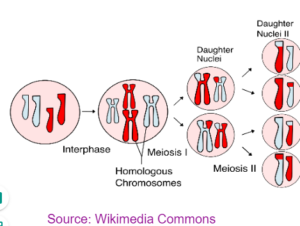
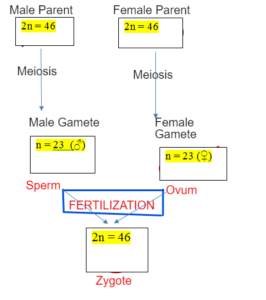
REPRODUCTIVE CYCLE IN FUNGI
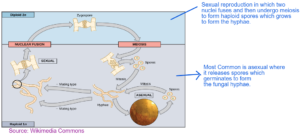
REPRODUCTIVE CYCLE IN PLANTS
Sexual reproduction involves the fusion of pollen grain with the egg nuclei forming zygote which forms the seeds and germinate to form a new plant.
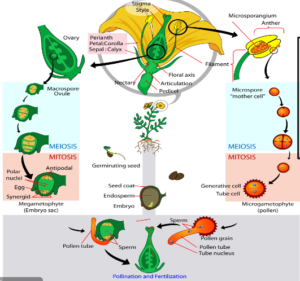
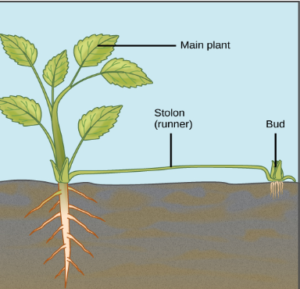
Sexual reproduction in plants in the form of runner, stolon or tuber which produces genetically identical plants.
REPRODUCTIVE CYCLE IN MALARIA
Liver Cell
- Asexual reproduction to form lot of malarial parasite spores
Blood Cells
- Formation of male and the female gamete of the parasite.
Mosquito
- Sexual reproduction in the mosquito forming zygotes and it divides to form spores of pathogens which enters saliva and then is injected into healthy person.
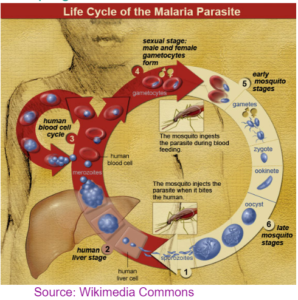
DNA – Deoxyribonucleic acid
Deoxyribonucleic acid (DNA) is a large macromolecule made up of a large number of monomeric units of nucleotides. Each nucleotide is composed of nucleoside and a phosphate group
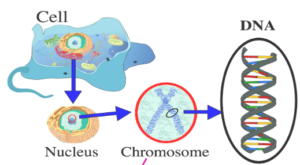
Chromosome – These are the structure that holds our genetic information
DNA – Double Helical Structure which contains genetic information
Gene – It is the segment of DNA that code for protein
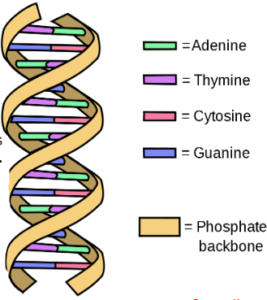
DN
DNA : A POLYNUCLEOTIDE
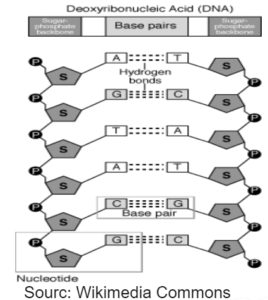
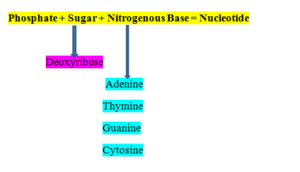
HUMAN GENOME
- Genome is the complete genetic materials of the organism.
- International collaboration to sequence around three billion bases and more than 20,000 genes.
Importance of Human Genome Project
- a) Understanding of genetic Diseases and inherited disorders
- b) Better personalised medicines
- c) Understanding Evolution
- d) Indentifying new drugs target.
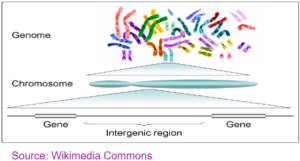
PROTEIN SYNTHESIS
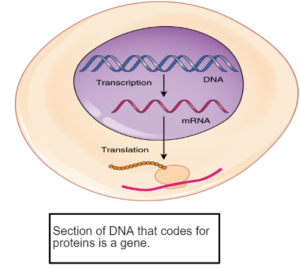
- The DNA copies the code and form mRNA by the process of transcription.
- The mRNA leaves the nucleus and reaches the ribosome.
- The ribosomes reads the bases in the sequence of three bases. The t-RNA brings the corresponding amino acid and forms polypeptide chain .
- The polypeptide chain than forms proteins.
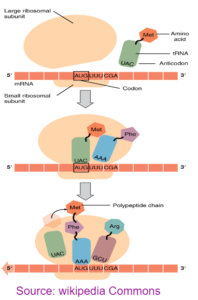
Mutations
- Can be silent, harmful or beneficial
A change in sequence of a gene or DNA
Results in the change in the sequence of the mRNA
Result in the change in amino acid
Result in the formation of non-functional protein or enzyme.
Change the structure of protein, the active site substrate can no longer fit into it
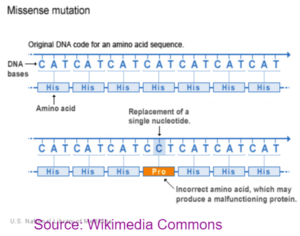
Banner 3
GENETIC TERMS
Chromosome – These are the structure that holds our genetic information
DNA – Double Helical Structure which contains genetic information
Gene – It is the segment of DNA that code for protein
Allele – the alternative factors located at the same locus on homologous chromosomes are called alleles.
Dominant Allele – It is able to express itself even in the presence of its recessive allele.
Recessive Allele – Unable to express its effect in the presence of dominant allele.
Homozygous – individual which contains identical genes or factors of a character on its homozygous chromosomes. E.g TT or tt
Heterozygous – individual which contains the two different or contrasting factors, genes or alleles of a character on its homologous chromosomes. e.g Tt
Genotype – It is the gene complement or genetic constitution of an individual with regard to one or more characters irrespective of whether the genes are expressed or not.
Phenotype – It is the external manifestation of gene products brought to expression
Punnett Square – It is a checker board used to show the result of a cross between two organisms.
Banner 4
Genetic Cross
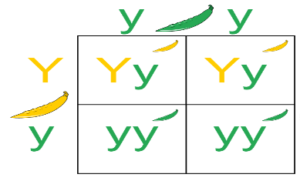
Heterozygous yellow plant with green plant.
Dominant: yellow Y
Recessive –green y
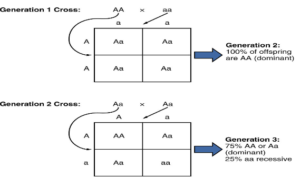
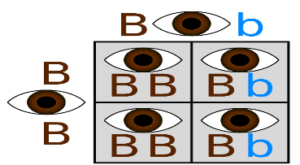
Heterozygous brown eyes with homozygous brown eyes.
B: Brown =Dominant
b: Blue: =Recessive
SEX DETERMINATION
Females XX
Male XY
50% changes of the offspring to be male or female
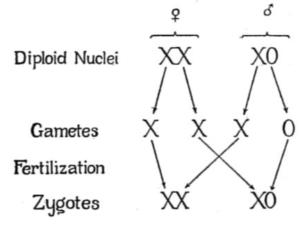
Banner 5
POLYDACTYLY
- Caused by dominant Allele
- If one of the parent has the allele offspring will have a disease.
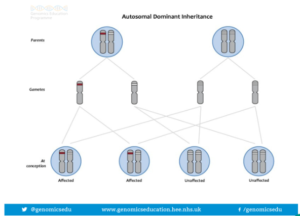
GENETIC DISORDER
- Caused by recessive allele
- Both the parent should have the allele to infect the offspring.
- The mucous becomes sticky and thick.
- It blocks the airways, reproductive tract and digestive tract.
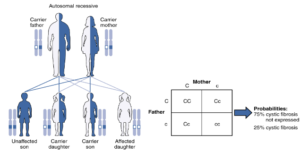
Baneer 6
GENETIC SCREENING
- Provides genetic counselling to the couple and helps to diagnose any problem before birth.
Amniocentesis
- Done at later stages Taking amniotic fluid which has fetal cells .
- The cells are then screened for genetic disorders.
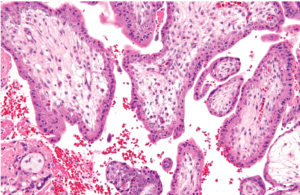
- Chorionic Villi Sampling
- Done at early stage and involve taking fluid from the placenta which contains fetal cells.
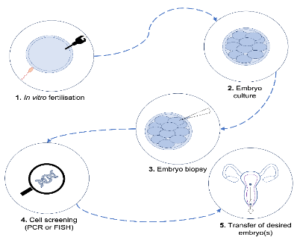
Banner 7
IVF Screening
Involves screening of the embryo after in vitro fertilization.
VARIATION – Differences amongst the individual
| CONTINIOUS VARIATION | DISCONTINOUS VARIATION |
| It is environmental like height, weight. | It is genetic like blood group. |
| Graph is a bell shaped curve | Graph is like column graph having descrete values. |
Natural Selection
“Natural selection is the differential survival and reproduction of individuals due to differences in phenotype. It is a key mechanism of evolution, the change in the heritable traits characteristic of a population over generations.”- Wikipedia
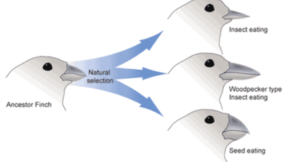
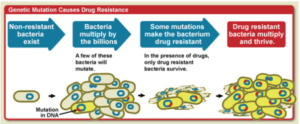
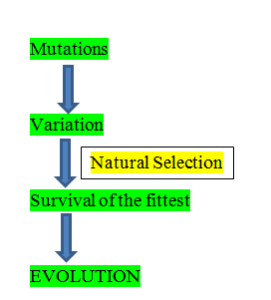
SELECTIVE BREDDING
- Artificially mating the two desirable characters parents to produce required offspring and selecting the ones with the best characteristics.
Applications
- a) Producing high milk yielding cow
- b) Producing diseases resistance and high yield crops.
DISADVANTAGES
- a) Slow process
- b) Time consuming
- c) Causes reduction in gene pool
- d) Undesirable traits can also get selected.
- e) A disease can result in elimination of whole population
Banner 8
GENETIC ENGINEERING
- Altering the gene by inserting the desired gene to produce genetically modified organisms.
- Isolation
- Inserting the gene with the vector (plasmid) to form recombinant DNA
- Introducing the recombinant into bacteria – Transformation
- Selecting transformed bacteria
- Growing transformed bacteria
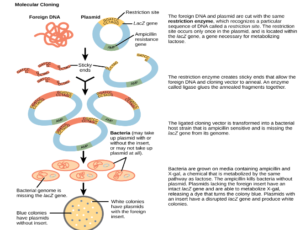
GENETIC ENGINEERING
Examples
- a) Tomato with greater shelf life
- b) Golden Rice which is rich in Vitamin A
- c) Gentically engineered Insulin
- d) Disease resistant crops
- e) Insects resistant crops
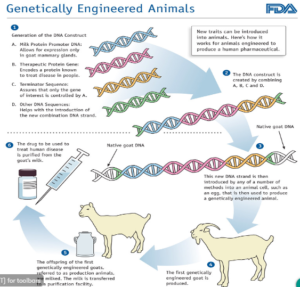
CLONING
- Taking Explant
- Growing and multiplying it in the nutrient medium
- Nutrient medium has all the hormones and minerals
- The new tiny plantelets formed are grown in the field
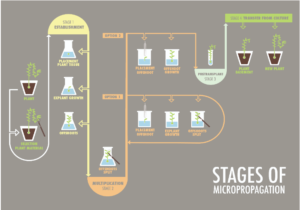
ADULT CELL CLONING
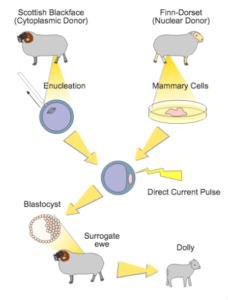
Banner 9
GENETIC ENGINEERING DEBATE
ADVANTAGES
- a) Produce Genetically Engineered crops which are high yielding
- b) Produce nutrient rich crops
- c) Produce high meat and high milk producing cows.
- d) Cure genetic disorders
- e) Can be used to produce medicines
- f) Can be used to produce food through microorganisms.
DISADVATANGES
- a) Reduce genetic diversity and variety
- b) Can result in sterile offspring
- c) Faulty genes or traits can also be transmitted
- d) It is expensive
- e) Ethical and religious concerns of playing with the nature.
- f) It is irreversible
GREGOR MENDEL
Genes Protein Expression
- In the 19th Century
- Father of Genetics
- He studied inheritance pattern in the pea plant
- He said that certain characters are inherited from one generation to another.
- In the 20th Century, the structure of DNA and the genes were discovered to build on Mendel Ideas
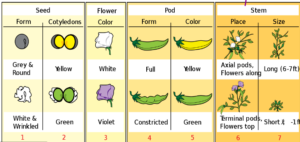
LAMARCK THEORY
Theory of Use and Disuse- If any characters in used it will develop and will be inherited others will be lost.
Example
- a) Giraffe had short necks and use to eat the grass
- b) As all grass were eaten away the giraffe stretched its neck to reach trees.
- c) The necks was used more and developed long necks
- d) The giraffe now acquired long necks.
Not all characters are inherited. Like Einstein did not give birth to an Einstein.
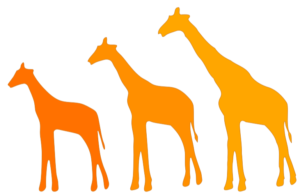
CHARLES DARWIN THEORY OF EVOLUTION
- Each Organism has potential to reproduce more than an environment can sustain
- The population remains constant due to natural selection
- Organisms show variation and nature selects the one which has desired characterstics.
- The one with desired characters survive and reproduce: Survival of the fittest
- The fittest one reproduce and pass the traits to next generation
EVOLUTION
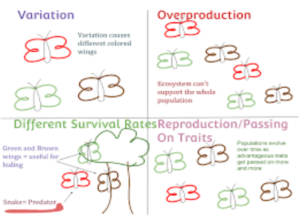
SPECIATION
Formation of new species
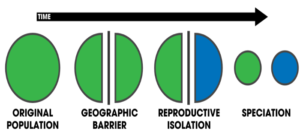
EVIDENCE OF EVOLUTION – FOSSILS
What are Fossils ?
- Fossils are the preserved remains of dead plants and animals that existed millions of years ago.
- Impressions, tracers or foot prints on the rocks are also considered as fossils.
How are Fossils formed ?
- They are formed by incomplete decay of the dead organsims due to hostile conditions for the decomposers.
- The harder part are replaced by minerals and are preserved as rock Impression on mud or rocks
Advantages
- Can give the information about extinct species.
- It can give the information about Evolution.
- Problems with Fossils
- Most of the animals that are soft bodies have no fossils
- Some of the fossils are yet to be discovered.
- No fossil record for some species’
FOSSILS AS EVIDENCE OF EVOLUTION
- Horse fossils record gives us the evidence of evolution
- From five digits it has developed hoofed limb and adapted to run on hard ground
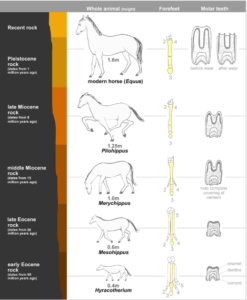
EXTINCTION
It the permanent loss of species
Causes
- a) Environmental Changes
- b) Diseases
- c) Predator
- d) Competition
- e) Catastrophic Event
Banner 10
CLASSIFICATION
Organising the species into groups according to the similar characterstics.
Advantages
- a) Helps to study the organisms easily
- b) Easy to identify unknown species
Basis
- a) Earlier organisms were classified on the basis of obeservable Characteristics
- b) Evolutionary Relationship
- c) DNA or protein sequencing
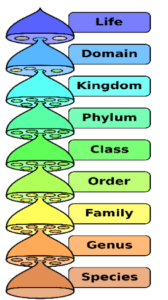
BINOMIAL NOMENCLATURE
- Each species is given two name
- The first name is Genus and is always capital
- The second name is species and it is written in lower case
- The name is italicised and if handwritten is underlined.
Homo sapiens
Genus name species name
- Universally accepted
- Helps the scientists to communicate
THREE DOMAIN CLASSIFICATION
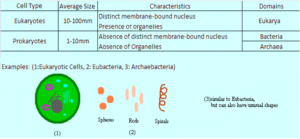
Banner 11
KEY TERMS
Asexual Reproduction – When offspring is produced by a single parent with or without the involvement of gamete formation, the reproduction is called Asexual.
Sexual Reproduction – Development of new individuals through the formation and fusion of male and female gametes.
Mitosis – Mitosis is a process of cell division that results in the development of two genetically identical daughter cells from a single stem cell.
Meiosis – Meiosis is the division of a germ cell that involves two fissions of the nucleus and gives rise to four gametes, or sex cells, each with half the number of chromosomes of the original cell.
Fertilization – Fusion of male and female gamete.
Variation – Variations are the differences found amongst individuals of the same species, race and family.
Natural Selection – Natural selection is the process in which organisms with favorable traits are more likely to reproduce.
Genome – It is a complete set of chromosomes when every gene chromosome is represented singly as in a gamete.
DNA – Double Helical Structure which contains genetic information
Chromosome – These are the structure that holds our genetic information
Allele – the alternative factors located at the same locus on homologous chromosomes are called alleles.
Nucleotide – A nucleotide is an organic molecule that is the constitutive element of DNA and RNA.
Transcription – formation of RNA or ribonucleic acid over DNA template is called transcription.
Translation – It is the process by which linear sequence of nucleotides or codons in a molecule of mRNA directs the specific linear sequence of amino acids in apolypeptide.
Gene Expression – A mechanism by which a gene is able to express itself in the phenotype of an organism.
Mutations – a new sudden inheritable discontinuous variation which is caused by a change in the nucleotide number, type and sequence of a DNA segment representing a gene or cristron.
Homozygous – individual which contains identical genes or factors of a character on its homozygous chromosomes. E.g TT or tt
Heterozygous – individual which contains the two different or contrasting factors, genes or alleles of a character on its homologous chromosomes. e.g Tt
Genotype – It is the gene complement or genetic constitution of an individual with regard to one or more characters irrespective of whether the genes are expressed or not.
Phenotype – It is the external manifestation of gene products brought to expression
Dominant Allele – It is able to express itself even in the presence of its recessive allele.
Recessive Allele – Unable to express its effect in the presence of dominant allele.
Punnett Square – It is a checker board used to show the result of a cross between two organisms.
Sex determination – It is a mechanism which brings about differentiation of sex, i.e, male and female, amongst organisms.
Cystic Fibrosis – Cystic fibrosis is an inherited disorder characterized by the accumulation of thick and sticky mucus that can damage many organs in the body.
Embryo Screening – a single cell is removed from an embryo two or three days after it has been conceived through in vitro fertilization and tested for genetic abnormalities.
Genetic Engineering – Genetic engineering refers to the direct manipulation of DNA to alter the characteristics of an organism (phenotype) in a particular way.
Variation – Variations are the differences found amongst individuals of the same species, race and family.
Evolution – Evolution is the change in the inherited traits of a population from generation to generation.
Natural Selection – Natural selection is the process in which organisms with favorable traits are more likely to reproduce.
Cloning – The term cloning describes several processes that can be used to produce genetically identical copies of a biological entity.
Tissue Culture – the process or technique for growing body tissue in a culture medium outside the body
Genetics – Study of heredity and variation in biological systems is called genetics.
Speciation – formation of new species.
Fossils – A fossil is the hard residue of a plant or a prehistoric animal that is found inside a rock.
Classification – classification is a mode of arranging organisms into categories according to a systematic plan as per nomenclature system.
Domain – Highest taxonomic rank of organisms in the three-domain system of taxonomy
Kingdom – It is the highest category of taxonomic studies.
Banner 12
Disclaimer:I have tried my level best to cover the maximum of your specification. But this is not the alternative to the textbook. You should cover the specification or the textbook thoroughly. This is the quick revision to help you cover the gist of everything. In case you spot any errors then do let us know and we will rectify it.References:
BBC Bitesize
Wikipedia
Wikimedia Commons
Image Source:
Wikipedia
Wikimedia
Commons
Flickr
Pixabay
Make sure you have watched the above videos and are familiar with the key definations before trying these questions. It is also good to time yourself while doing these questions so that you can work on the speed as well.
Cell Structure And Transport
- Cell Structure 1 MS
- Cell Structure 1 QP
- Cell Structure 2 MS
- Cell Structure 2 QP
- Cell Structure 3 MS
- Cell Structure 3 QP
- Transport in Cells 1 MS
- Transport in Cells 1 QP
- Transport in Cells 2 MS
- Transport in Cells 2 QP
- Transport in Cells 3 MS
- Transport in Cells 3 QP
Cell Division
- Cell Division 1 MS
- Cell Division 1 QP
- Cell Division 2 MS
- Cell Division 2 QP
- Cell Division 3 MS
- Cell Division 3 QP
Reproduction
Variation And Evolution
Genetics And Evolution


